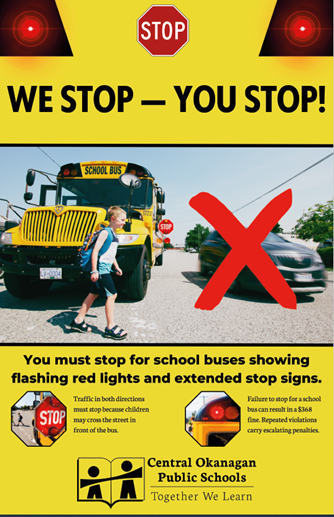SCHOOL BUS SAFETY FOR STUDENTS
School Bus Rider Rules
- Students should be at the bus stop 10 minutes before scheduled pickup time.
- Passengers must remain seated while the bus is in motion.
- Students shall sit facing forward with their feet in front of them.
- Do not put arms, hands or head out the window.
- The aisle of the bus must be kept clear at all times.
- No food or beverages may be consumed on the school bus. (other than a student's personal water bottle)
- Do not throw garbage/objects on the floor or out the window.
- Loud or noisy behavior is prohibited, as this is distracting to the Bus Driver.
- Guest riders are not permitted to ride on the school bus.
- Parent permission is required before a passenger may be dropped off at an alternate stop on the bus route. (parents to provide written permission)
- Possession/use of drugs, tobacco, vape pens or alcohol is prohibited on the school bus.
- Musical Instruments may be permitted on the school bus provided the student can hold the instrument in their lap or store it under the seat. (check with your bus driver before bringing band instruments onto the school bus)
Articles NOT Permitted on the School Bus
Skis & poles, Snowboards, Skateboards, Hockey Sticks, Golf Clubs, Fishing Rods, Animals or Pets, Firearms, Explosives, Combustible or anything of a dangerous nature that might endanger the lives or safety of others.
Getting to and from the School Bus Stop
- It is the parent's responsibility to ensure their child's safety getting to and from the bus stop or when waiting for the bus to arrive at the bus stop.
- Plan your child's walking route, review street names and landmarks while walking together.
- Make sure your child understands what to do if the bus is late or does not arrive at the bus stop.
Waiting for the School Bus
- Students shall gather in the "Safe Zone" at the bus stop
- Wait for the bus to come to a complete stop and the passenger door is open before entering or preparing to leave the school bus.
- Do not run or chase after the school bus, you may be in the "Danger Zone" and the driver may not see you.
Loading and Unloading from the School Bus
- ONLY cross in front of the school bus when the RED ALTERNATING LIGHTS are activated.
- Always wait for the safe "signal to cross" from the bus driver.
- Board in a single line and do not push or crowd your way on or off the school bus.
- Go directly to your assigned seat and remain seated as the bus driver may not depart the bus stop unless all passengers are seated.
STUDENTS WILL ONLY CROSS IN FRONT OF THE SCHOOL BUS WHEN THE RED ALTERNATING LIGHTS ARE FLASHING and THE TRAFFIC HAS COME TO A COMPLETE STOP and THE DRIVER HAS GIVEN THE SIGNAL IT IS OK TO CROSS!
*NOTE: in cases where the RED ALTERNATING LIGHTS are NOT used for unloading students; (Baltimore Stop)
- The student should wait in the safe zone to board the bus. When unloading from the school bus the student may be required to wait in the safe zone until the bus departs the stop.
- If the student must cross the street, they should always proceed to the crosswalk or intersection before crossing the street.
- NEVER cross behind the school bus.
"The School Bus Driver’s primary responsibility is ensuring the safety of all passengers, which requires their full attention on student safety and surrounding road conditions. If you have any concerns, please contact Transportation Services directly. We kindly ask that you refrain from problem solving with the driver at the bus stop. This can be distracting for the driver and could result in delays in the bus route schedule.
Click here to download our School Bus Safety handout for students
Teach your child to be a safe pedestrian and become street smart. All it takes is a little time to prepare, plan and teach your child how to be safe on the road.
Make learning fun for young children
a. Practice makes perfect. For young children, learning should be fun and interactive.
b. Quiz your child on traffic signs whenever using marked crosswalks, crossing lights and intersections.
c. Create a game to encourage your child to follow your footsteps.
Set a good example
a. Look left-right-left and shoulder check before crossing. Make eye contact with drivers and keep looking for approaching vehicles while crossing.
b. Listen. Remove your headphones so you can hear approaching traffic that may be hard to see.
c. Be seen. Wear reflective materials or bright clothes and use lights after dark.
d. Walk on the inside edge of the sidewalk away from the road. If there's no sidewalk - walk facing oncoming traffic, so you can see approaching vehicles.
e. Always use crosswalks and follow the pedestrian signals.
Be a good role model for your child when you're driving in school and playground areas.
a. Watch your speed. A 30km/h speed limit is in effect in school zones from 7:30 a.m. to 5 p.m. and in playground areas from dawn until dusk, unless otherwise posted.
b. Be patient. Drop off your child close to the sidewalk. Don't let them dash from the middle of the road.
c. Know the law. Always yield to pedestrians and stop for school buses when their red alternating lights are flashing.
For more tips and information please visit the ICBC website
https://www.icbc.com/road-safety/teaching/Pages/road-safety-for-your-kids.aspx
"WE STOP – YOU STOP"
Flashing Red Lights Mean STOP
(This includes at some SD23 schools, including bus pick-up and drop off lanes)
Safety is Everyone's Responsibility




